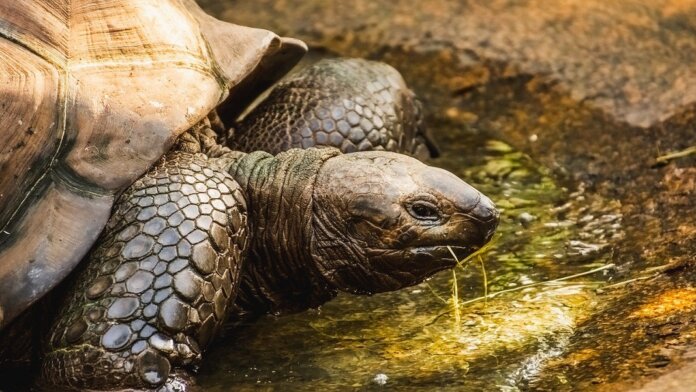Ever wondered about the secret to a long life? Perhaps understanding the lifespans of other animals with backbones (vertebrates) might help us unlock this mystery.
You’ve probably heard turtles live a long (and slow) life. At 190 years, Jonathan the Seychelles giant tortoise might be the oldest land animal alive. But why do some animals live longer than others?
Research published last month in the journal Science investigates the various factors that may affect longevity and aging in reptiles and amphibians.
We used long-term data from 77 different species of reptiles and amphibians, all cold-blooded animals. Our work is a collaboration between more than 100 scientists with up to 60 years of data on animals that were caught, marked, released, and re-caught.
These data were then compared to existing information on warm-blooded animals, and several different ideas about ageing emerged.
What Factors Might Be Important?
Cold-blooded or warm-blooded
One popular line of thought we investigated is the idea that cold-blooded animals such as frogs, salamanders, and reptiles live longer because they age more slowly.
These animals have to rely on external temperatures to help regulate their body temperature. As a result they have slower metabolisms.
Animals that are small and warm-blooded, such as mice, age quickly since they have faster metabolisms, and turtles age slowly since they have slower metabolisms. By this logic, cold-blooded animals should have lower metabolisms than similar-sized warm-blooded ones.
However, we found cold-blooded animals don’t age more slowly than similar-sized warm-blooded ones. In fact, the variation in aging in the reptiles and amphibians we looked at was much greater than previously predicted. So the reasons vertebrates age are more complex than this idea sets out.
Environmental temperature
Another related theory is that environmental temperature itself could be a driver for longevity. For instance, animals in colder areas might be processing food more slowly and have periods of inactivity, such as with hibernation, leading to an overall increase in lifespan.
Under this scenario, both cold and warm-blooded animals in colder areas would live longer than animals in warmer areas.
We found this was true for reptiles as a group, but not for amphibians. Importantly, this finding has implications for the effects of global warming, which might lead to reptiles aging faster in permanently warmer environments.
Protection
One suggestion is that animals with certain types of protections, such as protruding spines, armour, venom, or shells, also don’t age as fast and therefore live longer.
A lot of energy is put into producing these protections, which can allow animals to live longer by making them less vulnerable to predation. However, could it be the very fact of having these protections allows animals to age more slowly?
Our work found this to be true. It seems having such protections does lead to animals living longer. This is especially true for turtles, which have hard shell protection and incredibly long lifespans.
We’ll need to conduct more research to figure out why just having protections is linked to a longer life.
Reproduction
Finally, it has been posited that perhaps longevity is linked to how late into life an animal reproduces.
If they can keep reproducing later into life, then natural selection would drive this ability, generation to generation, allowing these animals to live longer than those that reproduce early and can’t continue to do so.
Indeed, we found animals that start producing offspring at a later age do seem to live longer lives. Sleepy lizards (or shinglebacks) are a great example. They don’t reproduce until they’re about 5 years old, and live until they’re close to 50!
The Challenge in Understanding Aging
To understand aging, we need a lot of data on the same animals. That’s simply because if we want to know how long a species lives, we have to keep catching the same individuals over and over, across large spans of time.
This is “longitudinal” research. Luckily, it’s exactly what some scientists have committed themselves to. It’s also what my team is doing with sleepy lizards, Tiliqua rugosa. These lizards have been studied continuously at Bundey Bore station in the Mid North of South Australia since 1982.
Here, more than 13,000 lizards have been caught over 40 years of study. Some have been caught up to 60 times! But given the 45-year longevity of these lizards, we’ve been studying them for a shorter time than some of them live. By keeping the survey work going we might find they live even longer.
Some Animals’ Chance of Dying Isn’t Linked to Age
Another interesting part of this research was finding, for a range of animals, that their chance of dying is just as small when they’re quite old compared to when they’re young. This “negligible aging” is found in at least one species across each of frogs, salamanders, lizards, crocodiles and, of course, in tortoises like Jonathan.
We’re not quite sure why this is. The next challenge is to find out, perhaps by analyzing species genomes. Knowing some animals have negligible aging means we can target these species for future investigations.
Understanding what drives long life in other animals might lead to different biomedical targets to study humans too. We might not live to Jonathan the tortoise’s age, but we could theoretically use this knowledge to develop therapies that help stop some of the aging process in us.
For now, healthy eating and exercising remain surer ways to a longer life.![]()
This article is republished from The Conversation under a Creative Commons license. Read the original article.
Image Credit: Alexas_Fotos from Pixabay



